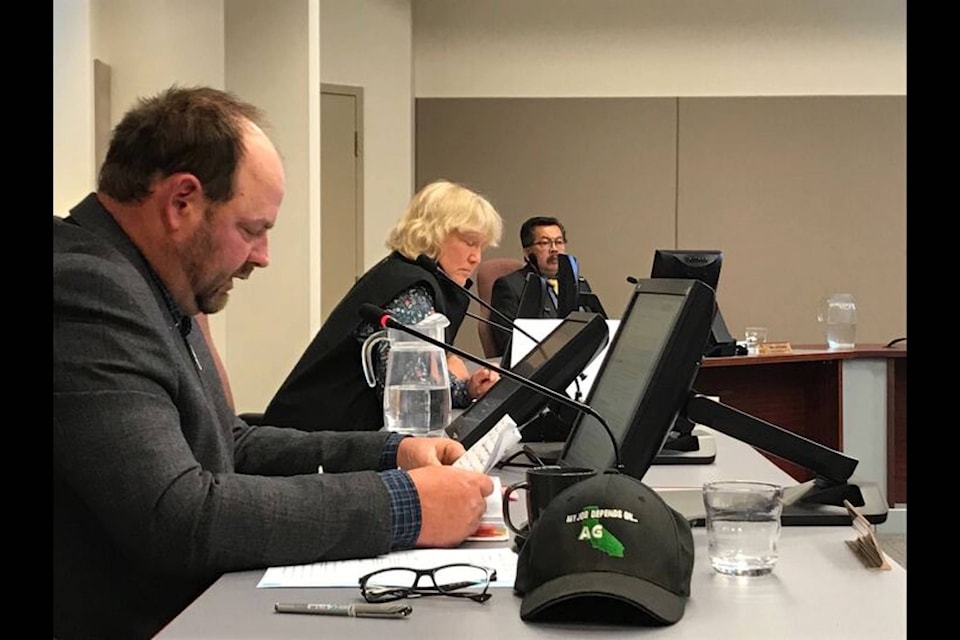The continued controversy of local land development took another step forward following Monday’s council meeting.
The District of Kent council voted 4-1 in favour supporting the removal of the Teacup properties from the Agricultural Land Reserve (ALR). Coun. Kerstin Schwichtenberg was the opposing vote.
A Brief History
The land in question consists of about 11 hectares of prime farmland just outside the Agassiz town site and has been the subject of debate and controversy for virtually a quarter of a century.
In the mid 90s, the district designated the land as residential and it was excluded from the ALR. In 2001, the land fell under residential reserve land in order to slate the land for future development as population migration began to put pressure on the real estate market in the area. As such, the Agriculture Land Commission (ALC) approved expansions around the town site.
RELATED: KAAC won’t back Kent’s Teacup properties plans
In 2005, the district council unanimously defeated the Gateway Neighbourhood plan, which would have removed the Teacup properties from the ALR. Following this decision, in-filling development began as did the creation of the Mount Woodside neighbourhood. The ALC said it was not in favour of the removal of the Teacup properties from the ALR and it remained as reserve residential.
In 2016, an applicant asked to exclude 14.4 hectares of Teacup land for residential and commercial development in exchange for 40.8 hectares of lesser-grade farmland with a $2 million contribution for district improvements and agricultural research as well as donation of its fertile topsoil to the district. The most recent application, which was developed back in January, now asks for 17.26 hectares to be replaced with 40.8 hectares of lower-grade farmland and a $3 million contribution as well as the donation of the topsoil.
The Kent Agricultural Advisory Committee (KAAC) declined a motion to support the application to remove the properties from the ALR. A public meeting held back in mid March, before COVID-19 measures were put in place, was very well-attended with a mixture of residents both for and against developing the Teacup properties.
RELATED: Deadline for Teacup properties survey approaches
A 13-question survey asking residents about the Teacup properties and possible future plans went out, collected in late March. The survey ultimately saw 473 participants from the survey. 55 per cent of participants said they were not in favour of the exclusion; 44 per cent said yes, and one per cent of participants were undecided.
Currently, the main crux of the argument against development is the need to preserved the rare, high quality of the farmland that comprises the Teacup properties. The argument for development boils down to the equally pressing need for a rapid response to the high population growth that continues to press eastward toward the district, which puts financial and physical pressure on housing, utilities and much more.
What Council Said
Coun. Stan Watchorn made the initial motion to support with Coun. Susan Spaeti seconding.
Mayor Sylvia Pranger, who supports the current application, previously voted against the exclusion proposal back in 2004. She said since that time, district staff has worked hard to adapt the exclusion proposal as the district grew in both business and in population.
While acknowledging the increasing need for viable housing in the area, Mayor Pranger said she doesn’t support commercial development in the Teacup properties as she feels downtown could be further commercially developed. She said she appreciated feedback, especially those who came up to her personally; some people who approached her who said they were in favour of development feared commercial and personal backlash for expressing said opinion.
Coun. Duane Post, another supporter, said the $3 million contribution from the applicant could be used to further develop agricultural research, which could help make the current farmland even more efficient. He said in his mind, this was about adding more than just additional people to the district but also a free exchange of new ideas and opportunities for economic growth.
Spaeti voted against the proposal previously, and she said this was the most difficult decision she’s faced as a councillor and she acknowledged that no matter what happens, there will be at least some who feel the wrong decision was made. She said the school district continues to lose families due to housing, residents have had to leave town to fill basic needs and local employees do not have places to live nearby without additional land on which to build. She said she believes the timing is right at this time, after weighing the options. She voted in favour.
Coun. Schwichtenberg, a consistent opponent to the exclusion application, pointed out the KAAC’s refusal to support the application when they met earlier this year. She said that though the margin was close, a majority of people, according to those who participated in the survey, still expressed their disapproval of the applicaiton. Schwichtenberg also said that, in her mind, the pandemic highlighted the need to bolster food security by holding on to fertile agricultural land.
Following this, Mayor Pranger said the council was not ignoring the comments of the people and they would still continue to be taken into consideration.
Coun. Watchorn, a supporter, echoed Spaeti’s point of the difficulty of this decision. He said the needs of the community in the need for housing and beyond ultimately swayed his favour of the application.
What Happens Now?
With Monday night’s vote, the application will eventually move on to the ALC for consideration. If the ALC approves it, this could trigger a battery of studies and plans, including the timing of each development, traffic planning, permitting and much more.
adam.louis@ahobserver.com
Like us on Facebook and follow us on Twitter
Want to support local journalism during the pandemic? Make a donation here.
